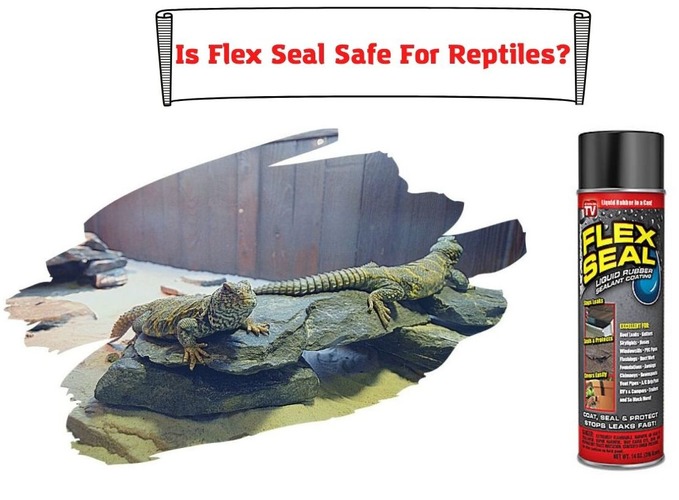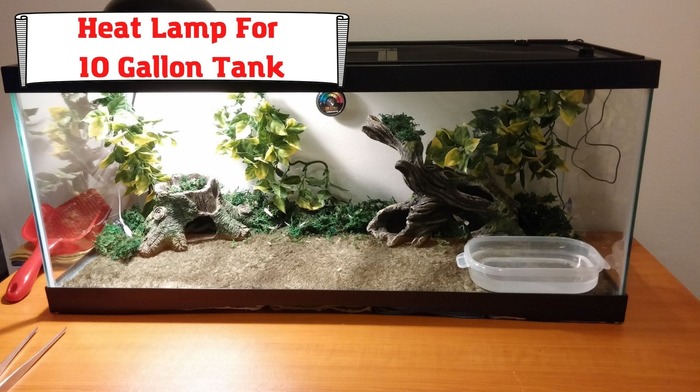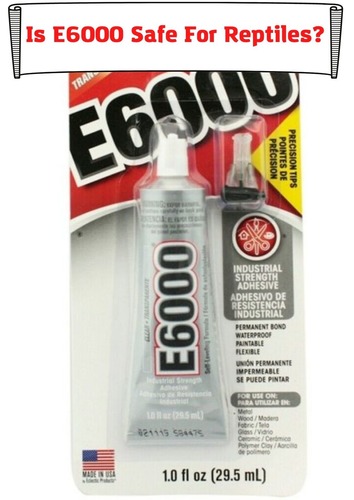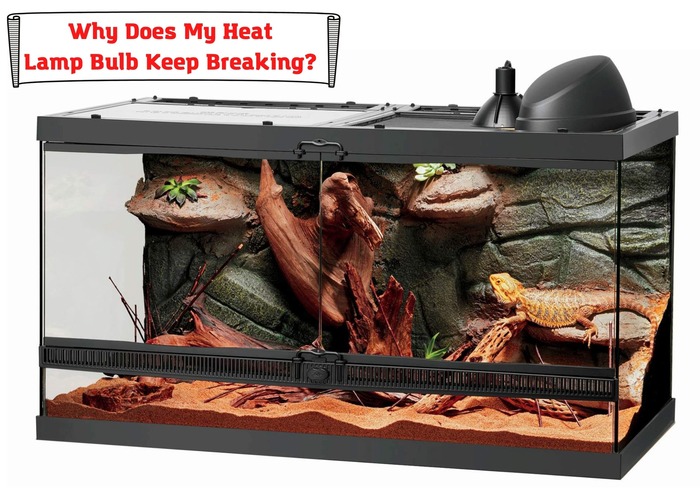
Every reptile owner has gone through the frustrating experience of finding and maintaining the right temperature for their reptiles. Initially, you’d thought that buying a good heat lamp bulb for your dragon’s tank would do the trick, but soon enough, you see the bulb break, and you’re back to right where you began.
Every week, your bulb breaks, and you’re worried that your reptile would have to freeze in the cold. Your budget will grow shorter because these things are expensive! And most likely, you’ll start hating the idea of going on another ventured bulb trip to the market.
So the question is:
- Is it really necessary for you to buy 20 different bulbs?
- Why are they breaking or burning out so soon?
- And yes, are there any viable solutions to this problem?
Let’s find the answers to all of these questions.
Why is the Heat lamp so important?
Reptiles come from a generally warm environment. Their systems thrive in places with high temperatures.
- The warmth helps them with digestion.
- It reduces excessive brumation—periods of your reptile going into hibernation.
- And if it is a UVB light, then you can ensure that your reptile receives a sufficient dosage of Vitamin D for its bones.
Reptiles naturally have cold blood in their systems, and their bodies cannot produce the heat their body needs to manage their temperature.
This lack of body heat is why reptiles need external sources such as heat lamps to warm them up.
Your reptile needs four varying degrees of temperature, as you may already be aware. They can last about 24 hours (at the room temperature of 18°C) without proper heat before it starts affecting their health. Parasite attack, bacterial infections, malnutrition, weight loss, all of these things could be a consequence of lack of heat.
Why Does Your Heat Lamp Keep On Breaking?
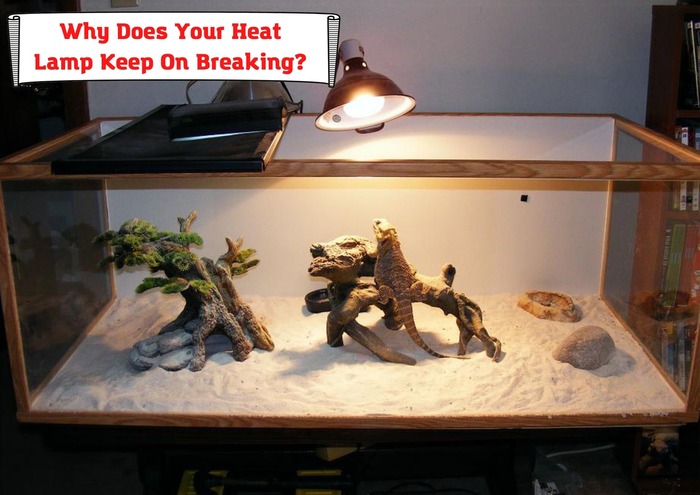
So, now you know why your heat lamp shouldn’t break and for how long your reptile is safe without sufficient heat. Let’s talk about why your heat lamp bulbs keep breaking or burning out in the first place.
Jolts and Movements in the Fixtures
These heat lamp bulbs are very fragile. You need to be sure that you handle them with care, or they may get damaged on your way home. The same tip goes for when you’ve installed the bulb inside the tank. So try not to touch the lid or jerk move the tank too much for a longer bulb shelf life.
Heat Lamp Burning Up
Sometimes the heat lamp bulb overheats because of rapid voltage fluctuations or when their wattage restriction is not suitable for the tank and the voltage of the light fixtures inside it.
The tank is enclosed, so it has less ventilation for the heat. All of these reasons can burn out your heat lamp bulb before its expected shelf life.
Circuits and Wiring Issues
A possible reason for your heat lamp bulb burning out too soon is if it short circuits. Problems with the wiring, socket, or plug could lead to burnout. Seeing your last busted bulb parts could help you confirm if they had these defects in them.
Touching the Bulb
Some papers say that you should use something like a towel or a set of gloves when you touch your bulbs. Handling them with bare hands can cause them to die out quickly because human hands create original oils, damaging the bulb with too much contact.
Water and Temperature
Varying temperatures could also be a cause for the bulb burning out soon. If you use water to clean your tank, it could shift your bulb from hot to cold too rapidly, causing it to crack.
Wrong Fixture and Bulb Connection
One other condition where the bulb does not work well is when the bulb is not connected correctly. It makes the connection between the bulb and the volt weak, making it frayed out before it has delivered its paid worth. Finding a technician to connect the fittings of your bulb properly might save you the trouble of buying another one.
Batch by Brand
Some brands, sadly, do create an inferior set of bulbs. The bulbs don’t either serve the heating purpose well. It’s been manufactured wrong or made using materials bound to wear off quickly. If you’ve always used the same brand, and it breaks off consistently, perhaps the problem is not in the way you handle the bulb but more in the bulb itself.
Why is the breakage a problem?

You can’t keep on buying bulbs every week, but you can’t keep your reptile freezing in the cold either. You know how important heat is for your reptile.
The most difficult part is that the bulb can stop working at any time—while you’re away at work or on a day-long trip.
Here is how you can mitigate that worry.
Where to Place the Bulb?
So, you have a variety of bulb types at your disposal. Whichever you select for your tank, they all need to be an appropriate distance away from your reptile to minimize any unnecessary movement in place or contact.
You can choose a fluorescent tube, standard or compact, to heat and light your tank. Compact tubes take lesser space and power while providing the proper level of heat. But they have been seen to cause damages, such as eye burns, to reptiles. Hence, they should be kept a reasonable distance away from your reptile. Compact tubes last for about a month or two at most.
Standard tubes need to take about 80% of your tank to be effective and 6 to 12 inches apart from your reptile. Standard fluorescent tubes last longer too—about six months on average. They have great UVB results in the tank, and they distribute the light and heat evenly across it.
Mercury vapor bulbs provide heat, UVA, and UVB to your tanks. They are expensive but have a longer life (12 months). They can only cover the tank’s focused area, and they need to be placed 20 inches over the tank’s base, right over your reptile. On the other hand, halogen floods are also an alternative. They cover a wider area for both light and heat.
It is recommended that before you decide on the placement of the bulbs, you read the manufacturer’s direction.
Another good tip is not to place the bulb over a glass covering. It will reduce the heat radiation. You can, however, use a screen cover to support or partition the bulb from the tank.
Use of Other Lighting Accessories

Apart from taking care of the placement and getting a professional electrician to connect your lights properly, you can also use accessories that will help prolong the life and benefits of your heat lamp bulb.
Set Your Bulb to Light Timers
These timers are pretty much like a normal timework. They are convenient as they reduce the need for you to remember how much time your reptile has had of light each day. It’s automatic. So if you set the timer, you won’t have to worry about maths and memory being a problem.
It’s also an excellent initiative to ensure that your bulb isn’t overly used and heated, which could, in the end, lead to burnout.
Dimmers
If you want to control the intensity of heat and light your reptile should get (which you should, considering their need for varying degrees of temperature), a dimmer is what you need.
It’s attached to the bulb, and you can use one bulb to fit all seasons and your reptile’s temperature needs.
Thermometers
Keep a reptile thermometer at hand. This thermometer will help you consider the level of heat and humidity inside the tank at timely intervals. So, if your tank has grown too hot for your bulb to bear or if you see your bulb’s performance deteriorating, then you’ll know before the bulb breaks or burns out.
You’ll be able to prepare earlier and even get it repaired before the damage is unrecoverable.
Finding the right brand from people who have priorly used a lamp with a longer life will make things easier for you. Generally, reptile owners find halogen lights to be a better alternative. It’s cheaper and long-lasting, but keeping a spare would always prepare you for any what-if situations.
In case you have a bulb shortage or the power goes out, you should immediately cover the tank with a blanket to trap as much heat as you can. You can use a thermometer to guide you through the required temperature and heat a water bottle to set it in the tank. Body-heat is another option, not one much liked by your reptile but a choice nonetheless.
Conclusion
If you’ve found yourself in this dilemma of light bulbs burning out every week, then you should use these points to get the most out of your heat lamp bulb and save yourself the trouble and the cost of constantly having to buy a new one.
- Can Dart Frogs Swim? Some Facts about Dart Frog in the Water - February 24, 2022
- Is Superglue Safe For Reptiles? Good Brands and Types of Glue - February 21, 2022
- Can You Put A Heat Lamp On Glass? Some Concerns and Recommendations - February 19, 2022
